The Post–doc Institute
Conducting a Faculty Search
Evaluating Faculty for Promotion and Tenure
Literature Updates:
WISE NEWS
|
|
Books:
- Beyond Bias and Barriers: Fulfilling the Potential of Women in Academic Science and Engineering (Committee on Science, Engineering, and Public Policy, The National Academies Press, 2006).
- Robert W. Drago, Striking a Balance: Work, Family, Life 2007, (Dollars & Sense, 2007).
- Sue V. Rosser, The Science Glass Ceiling: Academic Women Scientists and the Struggle to Succeed (Routledge, 2004).
- Virginia Valian, Why So Slow: The Advancement of Women (Cambridge, MA: MIT Press, 1999).
"The ubiquity of women's slow advancement requires a general explanation through the concepts of gender schemas and the accumulation of advantage. Gender schemas lead both men and women to see men as more competent and able than women, to respond more favorably to male than female leaders, and to attend and defer more to men than to women. Many of the cases in which a woman is disadvantaged are of small scale. The notion of the accumulation of advantage demonstrates how even small–scale disadvantages can mount up over time."
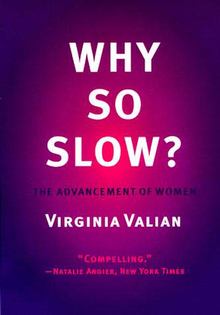
Statistics on women in science:
- Gender Differences at Critical Transitions in the Careers of Science, Engineering, and Mathematics Faculty National Academies Press 2009 link
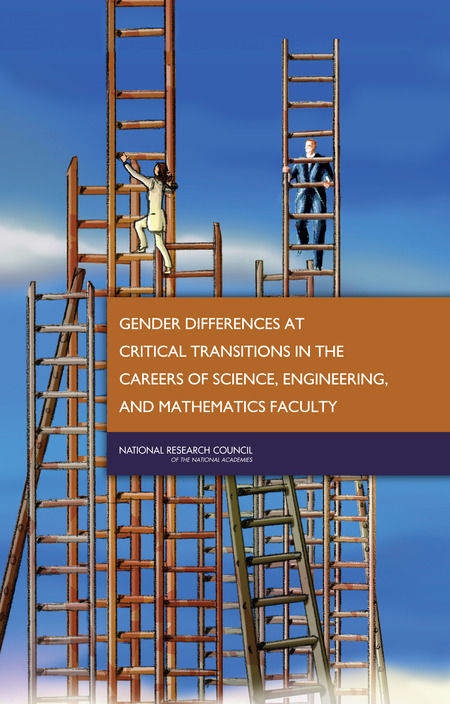
- Faring Well or Disappearing? AWIS Responds to National Academies Report on Gender Differences at Critical Transitions in the Careers of Science, Engineering, and Mathematics Faculty Inside Higher Ed June 3, 2009 link
- Publications on Science and Engineering Statistics from NSF Division of Science Resources Statistics link
- Report on Early Career Progress of NRSA Predoctoral Trainees and Fellows link
- This report provides data on the participation of women, minorities, and persons with disabilities in science and engineering education and employment.
IT Workforce: Retention of Women and Minorities link
- Donna Nelson and Christopher N. Brammer, "A National Analysis of Minorities in Science and Engineering Faculties at Research Universities" (second edition Jan. 4, 2010), view report here
- Donna J. Nelson, Final Report "A National Analysis of Diversity in Science and Engineering Faculties at Research Universities", a final report of FY2002 data, revised 2007. link
- "An Agenda for Excellence: Creating Flexibility in Tenure–Track Faculty Careers" American Council on Education, (2005). Executive Summary
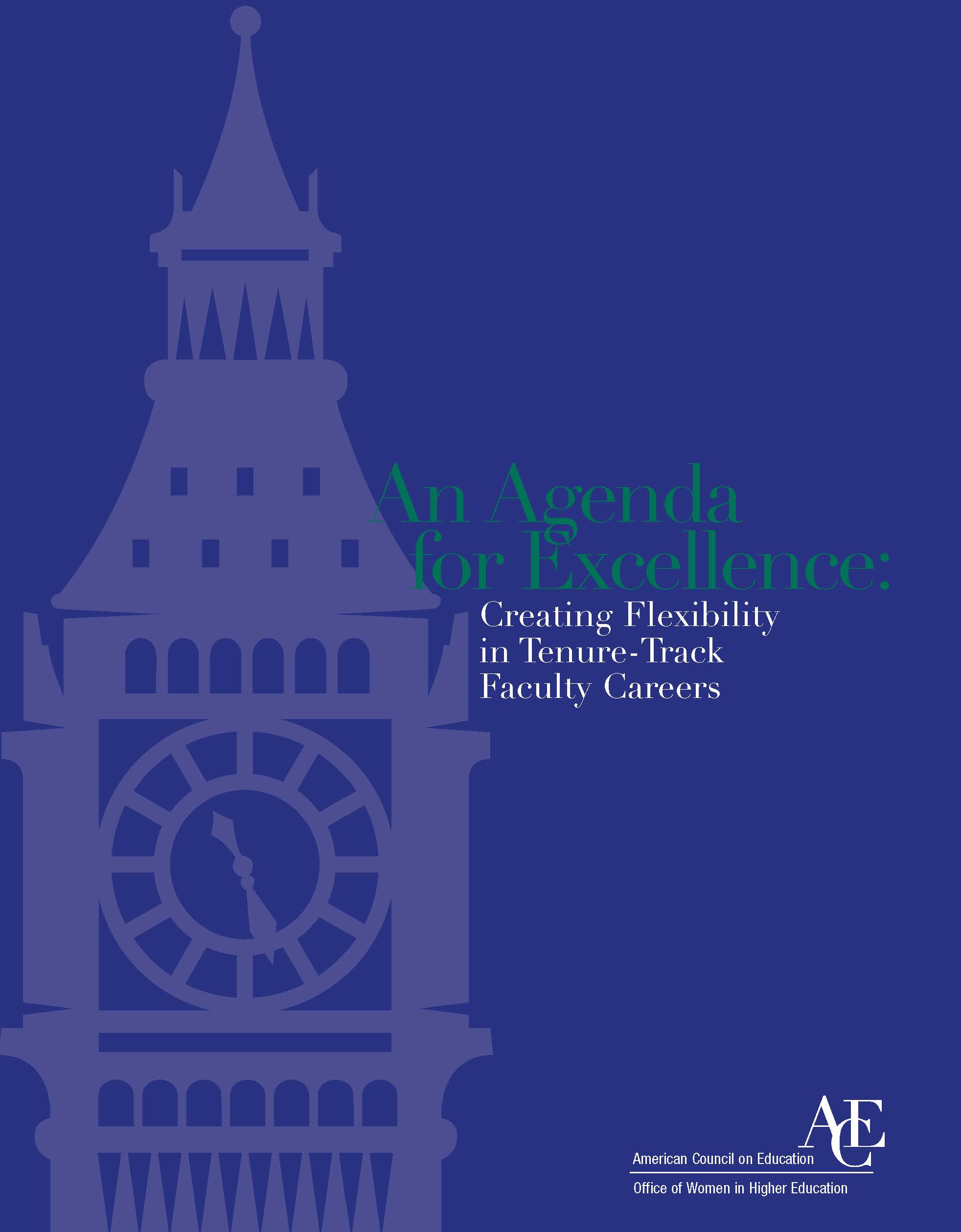
Who succeeds in science, gender differences:
- Patricia Boyer and Irv Cockriel, Women Faculty Pursuing Grants: Gender Differences, 1999 link
Female faculty overall, submitted fewer proposals and had fewer proposals funded than their male counterparts.
- Sonnert, G. and Holton, G. Who Succeeds in Science? The Gender Dimension (Rutgers University Press, 1995).
- From Scarcity to Visibility: Gender Differences in the Careers of Doctoral Scientists and Engineers National Academy of Sciences 2001 link This study looks at women in science and engineering careers in the 1970s and 1980s, documenting differences in career outcomes between men and women and between women of different races and ethnic backgrounds.
- Georgi, Howard. (2000). "Is There an Unconscious Discrimination Against Women in Science?" APS News Online. College Park, Maryland: American Physical Society. link
- Elizabeth A. Corley, How Do Career Strategies, Gender, and Work Environment Affect Faculty Productivity Levels in University–Based Science Centers? Review of Policy Research, Volume 22, Number 5 pp. 637–655 (2005). link
- Yu Xie and Kimberlee A. Shauman, Sex Differences in Research Productivity: New Evidence about an Old Puzzle, American Sociological Review, Vol. 63, No. 6 , pp. 847–870 (1998). link
- J. Scott Long, Measures of Sex Differences in Scientific Productivity, Social Forces, Vol. 71, No. 1, pp. 159–178 (1992). link
Using the longitudinal productivity data of 556 male and 603 female biochemists, Long found that sex differences in the number of publications and citations increase during the first decade of the career, but are reversed later in the career. He also found that papers by women on average receive more citations than those by men.
- Ginther, D.K., Schaffer, W.T., Schnell, J., Masimore, B., Liu, F., Haak, L., and Kington, R.,Race, Ethnicity, and NIH Research Awards. Science, 333(6045):1015–1019 (2011). link A team of researchers at the NIH, the University of Kansas in Lawrence
and the data–mining company Discovery Logic of Rockville, Maryland, analysed more than 83,000 applications from more than 40,000 researchers
to the NIH's largest grant programme for individual investigators, the R01, between 2000 and 2006.
After controlling for the applicant's educational background, country of origin, training, previous
research awards, publication record, and employer characteristics, it is found that black applicants
remain 10 percentage points less likely than whites to be awarded NIH research funding.

- Jason M. Sheltzer and Joan C. Smith, Elite male faculty in the life sciences employ fewer women, PNAS 111( 28 ) 10107–10112 (2014).link Shows that high–achieving faculty members who are male train 10–40% fewer women in their laboratories relative to the number of women trained by other investigators. These skewed employment patterns may result from self–selection among female scientists or they may result from conscious or unconscious
bias on the part of some faculty members. The dearth of women who are trained in these laboratories likely limits the number of female candidates who are most competitive for faculty job searches.
- Catherine Hill and Christianne Corbett, Solving the Equation: The Variables for Women's Success in Engineering and Computing, AAUW Report March 26, 2015,link
- Nicole R. Thomas, Daniel J. Poole, Joan M. Herbers, Gender in Science and Engineering Faculties: Demographic Inertia Revisited, October 21, 2015, PLoS ONE 10(10): e0139767. doi:10.1371/journal.pone.0139767, link The under-representation of women on faculties of science and engineering is ascribed in part to demographic inertia, which is the lag between retirement of current faculty and future hires."Our model shows that existing practices that produce gender gaps in recruitment, retention, and career progression preclude eventual gender parity. Further, we examine sensitivity of the convergence state to current gender gaps to show that all sources of disparity across the entire faculty career must be erased to produce parity: we cannot blame demographic inertia."
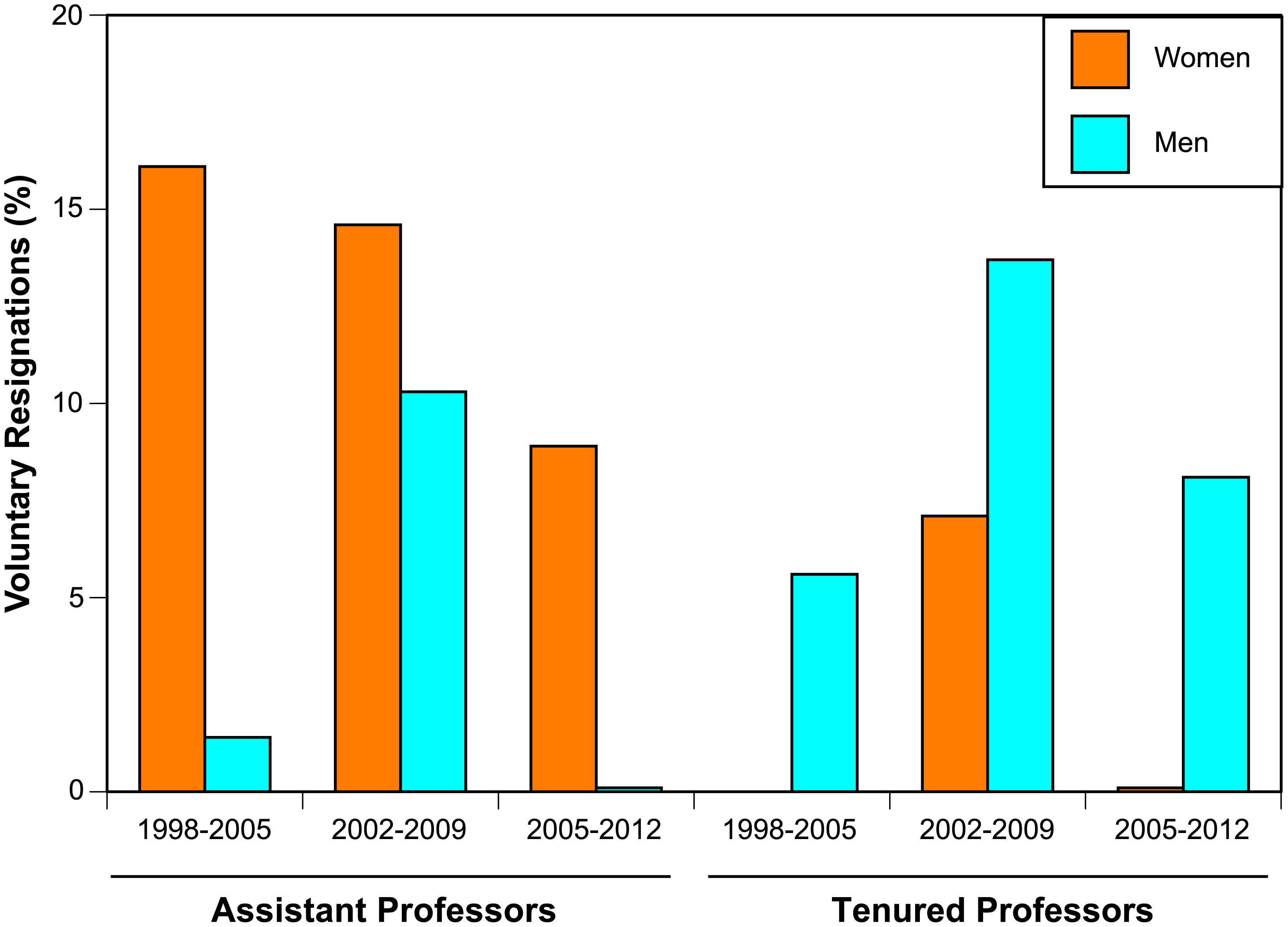
Gender–bias in evaluation:
- A shorter alternative to "Why So Slow" book:
Virginia Valian, Beyond Gender Schemas: Improving the Advancement of Women in Academia, NWSA Journal 16.1 (2004) 207–220 link
- C. Wenneras and A. Wold Nepotism and sexism in peer–review. Nature, 1997, 387, 341–343. link
This study assessed gender differences in ratings applications of postdoctoral fellowships from the Swedish Medical Research Council, as well as predictors of those ratings. Overall female applicants were rated lower than male applicants, and therefore the rate of awards to females was lower than that to males. Using objective criteria of scientific productivity, the researchers found that in fact female applicants had to be 2.5 times more productive than their male counterparts in order to receive the same "competence" ratings from reviewers. See review of this article link
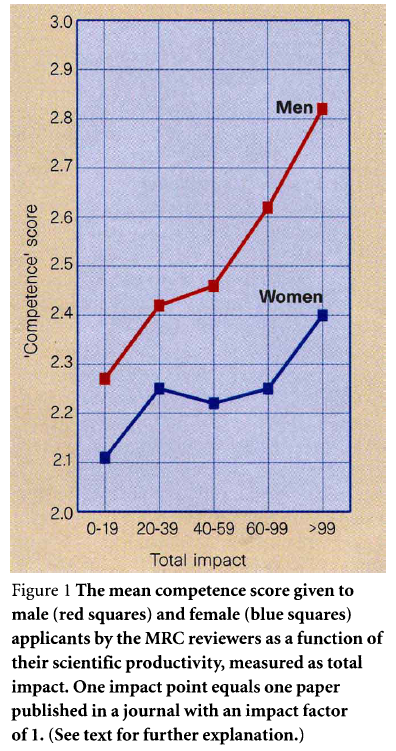
- Parallel findings were reported for US funding agencies in a 1994 GAO report on Peer Review: Reforms Needed to Ensure Fairness in Federal Agency Grant Selection. link Related issues have been raised in the recent (2004) GAO report Gender Issues: Women's Participation in the Sciences has increased, but Agencies Need to Do More to Ensure Compliance with Title IX. link
- R.E. Steinpreis, K.A. Anders & D.Ritzke The impact of gender on the review of the curricula vitae of job applicants and tenure candidates: A national empirical study. Sex Roles, 1999. 41, 7/8, 509–528. link
The authors of this study submitted the same c.v. for consideration by academic psychologists, sometimes with a man's name at the top, sometimes with a woman's. In one comparison, applicants for an entry–level faculty position were evaluated. Both men and women were more likely to hire the "male" candidate than the "female" candidate, and rated his qualifications as higher, despite identical credentials. In contrast, men and women were equally likely to recommend tenure for the "male" and "female" candidates (and rated their qualifications equally), though there were signs that they were more tentative in their conclusions about the (identical) "female" candidates for tenure.
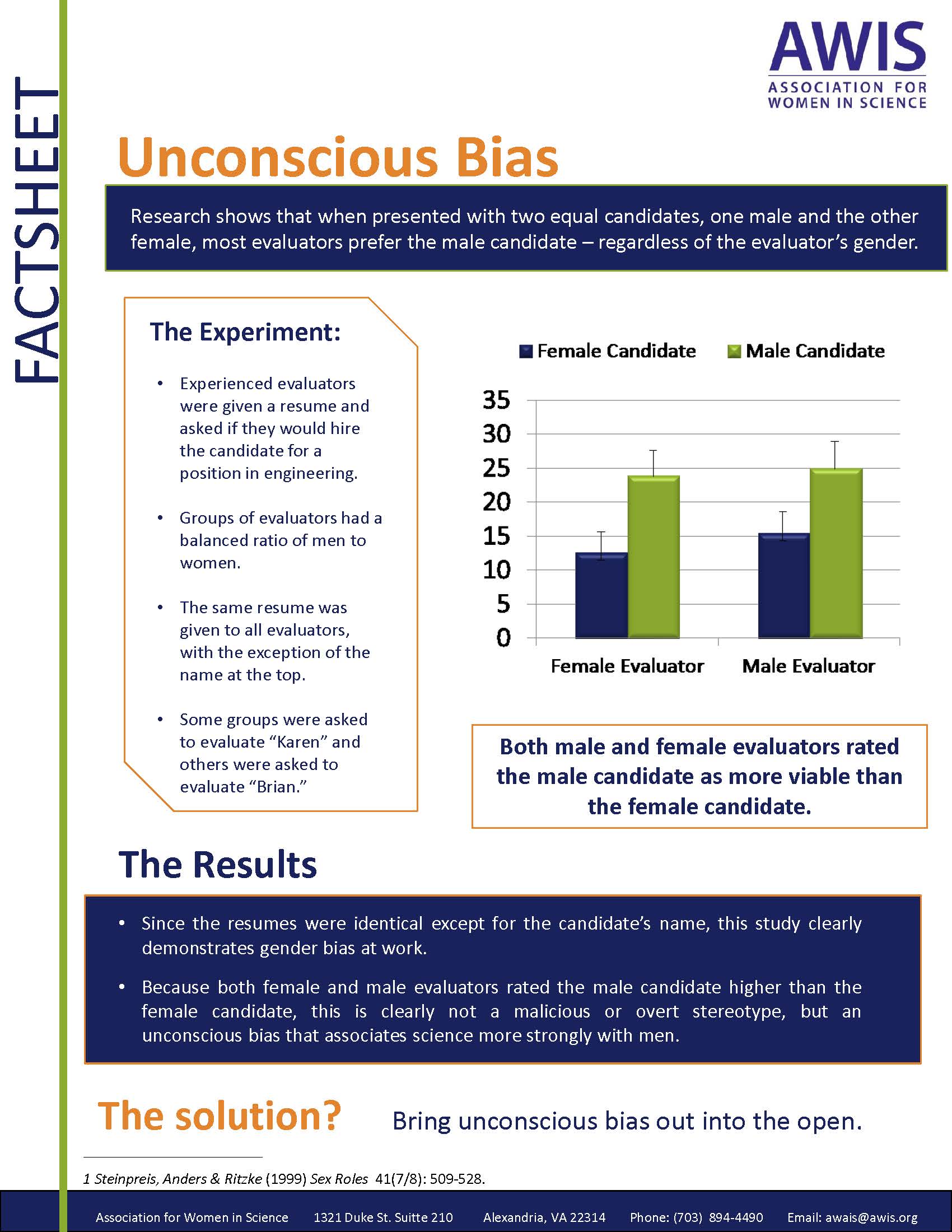
- F. Trix, and C. Psenka (2003). Exploring the color of glass: letters of recommendation for female and male medical faculty. Discourse & Society 14(2): 191–220. link
This study compares over 300 letters of recommendation for successful candidates for medical school faculty position. Letters written for female applicants differed systematically from those written for male applicants in terms of length, in the percentages lacking basic features, in the percentages with "doubt raising" language, and in the frequency of mention of status terms. In addition, the most common possessive phrases for female and male applicants ("her teaching" and "his research") reinforce gender schemas that emphasize women's roles as teachers and students and men's as researchers and professionals.
- M. Caffrey, (1997, May 12). Blind auditions help women. Princeton Weekly Bulletin. Based on C. Goldin & C. Rouse, (2000). Orchestrating impartiality: The impact of "blind" auditions on female musicians. American Economic Review, 90, 715–741. link
A change in the audition procedures of symphony orchestras—adoption of "blind" auditions with a "screen" to conceal the candidate's identity from the jury—provides a test for gender bias in hiring and advancement. Using data from actual auditions for 8 orchestras over the period when screens were introduced, the authors found that auditions with screens substantially increased the probability that women were advanced (within the orchestra) and that women were hired. These results parallel those found in many studies of the impact of blind review of journal article submissions.
- C.C. Bauer and B.B. Baltes "Reducing the effects of gender stereotypes on performance evaluations". Sex Roles, (2002). 9/10, 465–476. link
This study is one of many showing (1) that people vary in the degree to which they hold certain stereotypes and schemas (2) that having those schemas influences their evaluations of other people; and (3) that it is possible to reduce the impact of commonly–held stereotypes or schemas by relatively simple means. In this study, college students with particularly negative stereotypes about women as college professors were more likely to rate accounts of specific incidents of college classroom teaching behavior negatively, if they were described as performed by a female. In the second phase of the study students' reliance on their stereotypes was successfully reduced by providing them with time and instructions to recall the specific teaching behaviors of the instructors in detail. Thus, focusing attention on specific evidence of an individual's performance eliminated the previously–demonstrated effect of gender schemas on performance ratings.
- Marianne Bertrand and Sendhil Mullainathan, "Are Emily and Greg More Employable than Lakisha and Jamal? A Field Experiment on Labor Market Discrimination", MIT Department of Economics Working Paper No. 03–22. June 20, 2004 Available at SSRN link Job applicants with African American names get far fewer callbacks for each resume they send out. Equally importantly, applicants with African American names find it hard to overcome this hurdle in callbacks by improving their observable skills or credentials
- Ernesto Reuben, Paola Sapienza, and Luigi Zingales, How stereotypes impair women's careers in science, PNAS 111, 4403–4408 (2014) link
- Corinne A. Moss–Racusin, John F. Dovidio, Victoria L. Brescoll, Mark J. Graham, and Jo Handelsman, Science faculty's subtle gender biases favor male students, PNAS 109, 16474–9 (2012). link
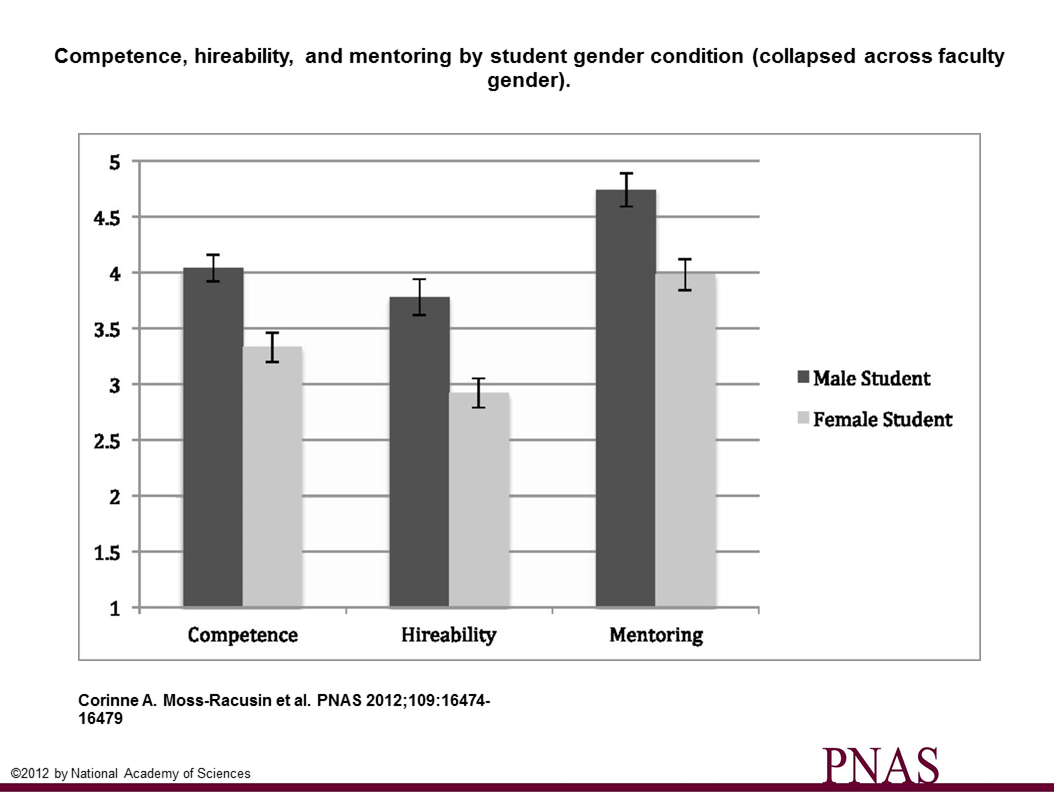
- Corinne A. Moss–Racusin , Aneta K. Molendaand Charlotte R. Cramer,Can Evidence Impact Attitudes? Public Reactions to Evidence of Gender Bias in STEM Fields, Psychology of Women Quarterly, 39(2) 194–209 (2015) link
Bias denial:
- W. M. Williams and S. J. Ceci, Academic Science Isn't Sexist, The New York Times, OCT. 31, 2014 Sunday Review link
- S. J. Ceci, D. K. Ginther, S. Kahn, and W. M. Williams, Women in Academic Science: A Changing Landscape, Psychological Science in the Public Interest, 15(3) 75&#ndaswh;141 (2014). link Contrary to research evidence in controlled experiments, these authors claim: "We conclude by suggesting that although in the past, gender discrimination was an important cause of women's underrepresentation in scientific academic careers, this claim has continued to be invoked after it has ceased being a valid cause of women's underrepresentation in math–intensive fields. Consequently, current barriers to women's full participation in mathematically intensive academic science fields are rooted in pre–college factors and the subsequent likelihood of majoring in these fields, and future research should focus on these barriers rather than misdirecting attention toward historical barriers that no longer account for women's underrepresentation in academic science. &#quot; Stephen Ceci and Wendy Williams have been denying that there is gender bias in STEM and keep writing articles in this vein. There must be other explanations, they claim, because there is no bias anymore.
Women of color:
- Catalyst. Women of Color in Corporate Management: Opportunities and Barriers. July 13, 1999 link One of first clear studies of women of color, and the unique issues they face.
- ELJ Edmondson Bell and SM Nkomo. Our Separate Ways — Black and White Women and the Struggle for Professional Identity. Boston, MA: Harvard Business School Press, 2001. Detailed qualitative and quantitative study, detailing the unique differences of successful African American women leaders as compared with Euro–American women leaders. Points out that African American women should not be equated with either women, or with African American men, because of the unique backgrounds, barriers, and career strategies that they use.
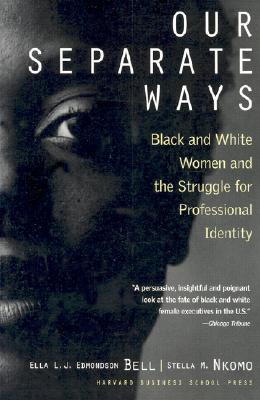
- R. A. Mickelson and M. L. Oliver "Making the Short List: Black Faculty Candidates and the Recruitment Process" in The Racial Crisis in American Higher Education. C. Kerr, (SUNY Press. 1991)
- D. Smith, "How to Diversify the Faculty." Academe, 86, no. 5. (2000). link also 2006 link Washington, D.C.: AAUP.
- Juanita Johnson–Bailey. "Hitting and Climbing the Proverbial Wall: Participation and Retention Issues for Black Graduate Women," Race, Ethnicity and Education 7, 4 (2004): 331–349.
- Kendra Hamilton, "Faculty Science Positions Continue to Elude Women of Color: Oklahoma Professor's Study Finds Hiring, Tenure Remain Stumbling Blocks,"
Black Issues in Higher Education 21 (3) 36 (2004).
Barriers and roadblocks:
- Anne E. Lincoln, Stephanie Pincus, and Vanessa Schick, Evaluating Science or evaluating gender? APS News June 2009 link
- Joan Williams, What Is Hidden Gender Bias in Academia? link
- Cornelia Dean, Women in Science: The Battle Moves to the Trenches, New York Times December 19, 2006 link
- Elizabeth A. Corley, How Do Career Strategies, Gender, and Work
Environment Affect Faculty Productivity Levels in University–Based Science Centers? Review of Policy Research, Vol 22, Number 5 (2005)
- Henry Etzkowitz, Carol Kemelgor, Michael Neuschatz, Brian Uzzi, &#quot;Barriers to Women in Academic Science and Engineering&#quot; in Willie Pearson Jr. and Irwin Fechter eds. Who Will Do Science? Educating the Next Generation, Baltimore: Johns Hopkins University Press, 1994.
link
- Catherine Hill, Christianne Corbett, Andresse St. Rose, Ed.D. Why so few? Women in Science, Technology, Engineering, and Mathematics, AAUW 2010.
link
In an era when women are increasingly prominent in medicine, law and business, why are there so few women scientists and engineers? A new research report by AAUW presents compelling evidence that can help to explain this puzzle. Why So Few? Women in Science, Technology, Engineering, and Mathematics presents in–depth yet accessible profiles of eight key research findings that point to environmental and social barriers — including stereotypes, gender bias and the climate of science and engineering departments in colleges and universities &#mdash; that continue to block women's participation and progress in science, technology, engineering, and math. The report also includes up to date statistics on girls' and women's achievement and participation in these areas and offers new ideas for what each of us can do to more fully open scientific and engineering fields to girls and women.
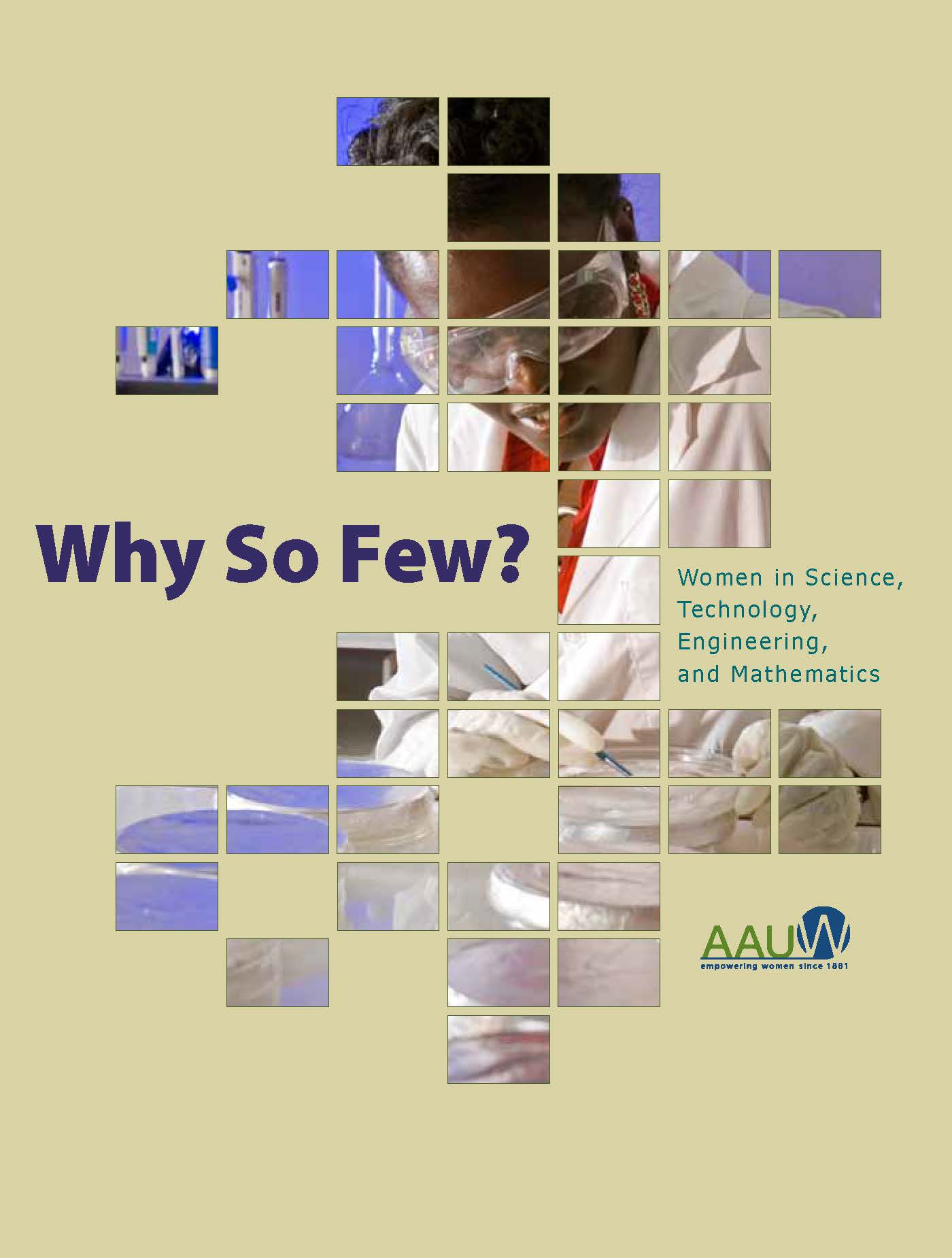
- Rebecca R. Kameny, Melissa E. DeRosier, Lorraine C. Taylor, Janey Sturtz McMillen, Meagan M. Knowles, Kimberly Pifer, Barriers to Career Success for Minority Researchers in the Behavioral Sciences, Journal of Career Development 2014, 41, 43–61. link Data were collected from a select group of minority researchers (defined for this study as women and/or people of color) who attended a 3–and–one–half–day intensive workshop developed specifically to address career barriers. Seventy–two percent (n = 43) encountered workplace barriers relating to race/ethnicity; 26% reported barriers related to gender.
- Shannon E. Holleran, Jessica Whitehead, Toni Schmader and Matthias R. Mehl,Talking Shop and Shooting the Breeze : A Study of Workplace Conversation and Job Disengagement Among STEM Faculty, Social Psychological and Personality Science, 2: 65–71(2011). link In this study, workplace conversations of 45 female and male STEM faculty were sampled using the Electronically Activated Recorder, a naturalistic observation method, coded for research or socializing content, and correlated with self–reported job disengagement. Both men and women were less likely to discuss research in conversations with female as compared to male colleagues, and when discussing research with men, women were rated as less competent than men. Consistent with the idea that women in STEM experience social identity threat, discussing research with male colleagues was associated with greater disengagement for women, whereas socializing with male colleagues was associated with less disengagement. These patterns did not hold for men. These findings point to the unique challenges women face in STEM disciplines.
Gender differences in science and math achievement:
- Janet S. Hyde and Janet E. Mertz, "Gender, culture, and mathematics performance", Proc. Natl. Acad. Sci. June 2, 2009 vol. 106 8801–8807.
- Brian A. Nosek et al. "National differences in gender—science stereotypes predict national sex differences in science and math achievement", Proc. Natl. Acad. Sci. June 30, 2009 vol. 106, 10593–10597.
- Diane F. Halpern, Camilla P. Benbow, David C. Geary, Ruben C. Gur, Janet Shibley Hyde, and Morton Ann Gernsbacher, The Science of Sex Differences in Science and Mathematics, Psychological Science in the Public Interest, Vol. 8, No. 1, August 2007 , pp. 1–51 Association for Psychological Sciences
- Elizabeth S. Spelke , Sex Differences in Intrinsic Aptitude for Mathematics and Science: A Critical Review, American Psychologist, Vol. 60, No. 9, 950&#ndash;958.
link
Impact of gender bias and stereotype threat:
- Elizabeth Redden, "Female Faculty and the Sciences" (Insidehighered.com, Oct. 18, 2007). Click here to view article.
- Ilan Dar–Nimrod and Steven J. Heine, "Exposure to Scientific Theories Affects Women's Math Performance", Science Vol. 314. no. 5798, p. 435–(2006). link
- Amy E Bell, Steven J Spencer, Emma Iserman, Christine E R Logel,
"Stereotype threat and women's performance in engineering" Journal of Engineering Education 92(4) 307–312 (2003). link
- J. Keller, "Blatant Stereotype Threat and Women's Math Performance: Self–Handicapping as a Strategic Means to Cope with Obtrusive Negative Performance Expectations", Sex Roles 47, (3–4), 193–198(2002). link
- M. A. D Sagaria "An Exploratory Model of Filtering In Administrative Searches: Toward Counter–Hegemonic Discourses." The Journal of Higher Education 73(6): 677–710. (2002). link
- J. Yoder, "2001 Division 35 Presidential Address: Context Matters: Understanding Tokenism Processes and Their Impact on Women's Work." Psychology of Women Quarterly, 26, 1–8 (2002). link
- S. J. Spencer, C.M. Steele, D.M. Quinn, "Stereotype Threat and Women's Math Performance", Journal of Experimental Social Psychology, 35(1), 4–28(1999). link
- Catherine Good, Joshua Aronson, Jayne Ann Harder, Problems in the pipeline: Stereotype threat and women's achievement in high–level math courses, J. Applied Developmental Psychology 29, 17–28 (2008). link
Reported here are results of a field experiment that tested the usefulness of the stereotype threat formulation for understanding women's performance in upper levels of college mathematics &#mdash; men and women who are highly motivated and proficient mathematicians and who are in the pipeline to mathematics and science professions. The pattern of results suggests that even among the most highly qualified and persistent women in college mathematics, stereotype threat suppresses test performance.
- Andy Martens Michael Johns, Jeff Greenberg, Jeff Schimel, Combating stereotype threat: The effect of self–affirmation on women's intellectual performance, Journal of Experimental Social Psychology 42, 236&#ndash;243 (2006). link
- Bell, A.E., S.J. Spencer, E. Iserman, and C.E.R. Logel, Stereotype Threat and Women's Performance in Engineering, Journal of Engineering Education, Vol. 92, No. 4, 307–312 (2003). link
- Claude M. Steele,Whistling Vivaldi And Other Clues to How Stereotypes Affect Us,Norton, New York, 2010. 256 pp. This book describes the groundbreaking work that he and his colleagues conducted over the past 20 years on stereotype threat, the psychological threat
of confirming or being reduced to a negative stereotype.

Faculty gender and student performance:
- S.E. Carrell, M. E. Page, J. E. West "Sex and Science: How Professor Gender Perpetuates the Gender Gap", link
This study examined the undergraduate careers of 9,481 cadets taught by nearly 250 different science and math instructors at the USAFA during the years 2000–08. They find that replacing a male instructor with a female one has such a strong effect on female achievement as to erase the gender gap entirely.
- The why chromosome: how a teacher's gender affects boys and girls. link
- Florian Hoffmann and Philip Oreopoulos, A Professor Like Me: The Influence of Instructor Gender on College Achievement. Journal of Human Resources 44(2): 479&#ndash;494 (2009).
link
Gender and student evaluations:
- Kristi Andersen and Elizabeth D. Miller, "Gender and Student Evaluations of Teaching". PS: Political Science and Politics, 30(2) 216–219 (1997). link
- Phyllis Baker and Martha Copp, "Gender performance matters most: The interaction of gendered expectations, feminist course content and pregnancy in students' course evaluations". Teaching Sociology 25(1), 29–43(1997). link
- Susan A. Basow, "Student Ratings of Professors are not Gender Blind". AWM Newsletter, Vol. 24, No. 5, Sept.–Oct. 1994. link
- Susan A. Basow, Student evaluations of college professors: When gender matters. Journal of Educational Psychology, 87(4), 656–665 (1995). link
- Susan Basow and N. T. Silberg, "Student evaluations of college professors: Are male and female professors rated differently?" Journal of Educational Psychology, 79(3) 308–314(1987). link
- S. K. Bennett, "Student perceptions and expectations for male and female instructors: Evidence relating to the question of gender bias in teaching evaluation". Journal of Educational Psychology, 74(2), 170–179 (1982). link
- A. G. Greenwald and G. M. Gillmore, No pain, no gain? The importance of measuring course workload in student ratings of instruction. Journal of Educational Psychology, 89, 743–751 (1997). link
- E. Kaschak, "Sex bias in students' evaluations of professors". Psychology of Women Quarterly, 2 (3), 235–243 (1978). link
- E. Kaschak, "Another look at sex bias in students evaluations of professors: Do winners get the recognition that they have been given?", Psychology of Women Quarterly, Vol 5 Issue s5, 767&#ndash;772 (1981). link
- D. Kierstead, P. D'Agostino, H. Dill, "Sex role stereotyping of college professors: Bias in students' ratings of instructors". Journal of Educational Psychology, 80(3), 342–344 (1988). link
- Elaine Martin, "Power and Authority in the Classroom: Sexist Stereotypes in Teaching Evaluations". Signs: Journal of Women in Culture and Society, 9, 482–492 (1984). link
- Deborah Merritt, "Bias, the Brain, and Student Evaluations of Teaching". St. John's Law Review, 82, 235–287 (2008). link
- J. Sprague and K. Massoni, "Student Evaluations and Gendered Expectations: What We Can't Count Can Hurt Us", Sex Roles, 53, 779–793 (2005).
- A. Statham, L. Richardson, J. Cook, Gender and university teaching: A negotiated difference (SUNY Press., 1991).
Gendered student–faculty interactions:
- Claudia Lampman. Alissa Phelps. Samantha Bancroft. and Melissa Benek, "Contrapower Harassment in Academia: A Survey of Faculty Experience with Student Incivility, Bullying and Sexual Attention", Sex Roles 60, 331–346 (2009) link .
This study defines contrapower harassment in academia as student incivility, bullying, and sexual attention aimed at faculty. Although men reported more sexual attention from students and comparable levels of student incivility—bullying, women reported that such behaviors were more upsetting and had a greater negative impact on their health and work–lives.
- S. A. Basow, "Gender dynamics in the classroom". in J. C. Chrisler, C. Golden, P. D. Rozee, Lectures on the psychology of women (2nd ed.). (New York: McGraw–Hill., 2000) ISBN13: 978–0072348606
- J. Miller and M. Chamberlin, "Women are teachers, men are professors: A study of student perceptions". Teaching Sociology, 28, 283–299 (2000). link
- Melanie Moore, "Student resistance to course content: Reactions to the gender of the messenger". Teaching Sociology 25(2), 128–33 (1997). link
- Joan V. Gallos, "When authority = she: a male student meets a female instructor". Journal of Management Development, 14 No. 2, 65–76 (1995). link
- B. R. Sandler, "Women faculty at work in the classroom, or why it still hurts to be a woman in labor". Communication Education (January), 6–15 (1991). link
- M. R. Schuster and S. R. Van Dyne, "The changing classroom". in M. R. Schuster and S. R. Van Dyne (Eds.), Women's place in the academy (Totowa, New Jersey: Rowman and Allanheld, 1985, ISBN 084767407X, 9780847674077) pp. 161–171.
- V. R. Brooks, "Sex differences in student dominance behavior in female and male professors' classrooms". Sex Roles, 8 (7), 683–690 (1982). link
- Joey Sprague and Kelley Massoni, Student Evaluations and Gendered Expectations:
What We Can't Count Can Hurt Us, Sex Roles, Vol. 53, Nos. 11/12, 779–793 (2005).
- Dennis E. Clayson and Mary Jane Sheffet, Personality and the Student Evaluation of Teaching, Journal of Marketing Education 28, 149–160 (2006). link
- Kristi Andersen and Elizabeth D. Miller, Gender and Student Evaluations of Teaching, Political Science and Politics, 30(2) 216–219 (1997). link
See also Gender and Student Evaluations: An Annotated Bibliography Developed at the Center for Research on Learning and Teaching at the University of Michigan, link
Lessons learned:
- J. McKenna, M. D'Iorio, A.C. McMillan and E.C. Svennson, Report On The First International Conference On Women In Physics, PHYSICS IN CANADA Nov / Dec 2002, 17–23. link
- J. Bickel, Women in Medicine: Getting In, Growing and Advancing (Thousand Oaks, CA: Sage Publications, 2000). New book summarizing the current status, and strategies for achieving success.
- PS Morahan, ML Voytko, S Abbuhl, LJ Means, DW Wara, J Thorson and CE Cotsonas. Ensuring the success of women faculty at AMCs — lessons learned from seven schools. Acad. Medicine 76, 19–31 (2001). link Comparative paper describing the activities and approaches used to advance women faculty, citing common lessons learned.
- Joann Moody, "Demystifying the Profession: Helping Junior Faculty Succeed" 40 pp (Moody Publications) original edition 1997 out of print, 2007 edition available from the author
- Joann Moody, "Rising Above Cognitive Errors: Guidelines for Search, Tenure Review, and Other Evaluation Committees" 40 pp (Moody Publications) 2007 edition available from the author
- Indicators of Climate For Women In Engineering (Schools/Faculties). How to Choose a Woman–Friendly Engineering Faculty/School link
- L. Austin, What's Holding You Back? Eight Critical Choices for Women's Success. 256 pages NY: Perseus/Basic Books, 2000. ISBN–10: 046503263X, ISBN–13: 978–0465032631. Excellent summary of several psychological barriers that inhibit women from seeking leadership.
- Jeanine Prime and Corinne A. Moss–Racusin, Engaging Men in Gender Initiatives: What Change Agents Need To Know, Catalyst 2009. link
- Top Issues And Solutions For Women Faculty In Science And Engineering link
- Mariann Ruderman and Patricia J. Ohlott, "What Women Leaders Want" Leader to Leader Volume 2004 Issue 31, Pages 41 – 47. link How to change the leadership culture: allow women to act authentically, encourage women to make connections, authorize women to act powerfully, foster feelings of wholeness, enable women to gain self–understanding.
- Amber E. Budden, Tom Tregenza, Lonnie W. Aarssen, Julia Koricheva, Roosa Leimu and Christopher J. Lortie, Double–blind review favours increased representation of female authors, Trends in Ecology and Evolution Vol.23 No.1, 4–6 (2007). link
- Corinne A. Moss-Racusin, Jojanneke van der Toorn, John F. Dovidio, Victoria L. Brescoll, Mark J. Graham, Jo Handelsman, Scientific diversity interventions. Science 343 (6171) 615–616 (2014). link The authors propose a scientific approach to the design, assessment, and broad implementation of diversity interventions. They review evidence of positive and negative outcomes of existing interventions relevant to academic scientists. They then offer an evidence–based framework identifying elements of successful interventions.
- Nadya A. Fouad, Romila Singh, Mary E. Fitzpatrick, Jane P. Liu, Stemming The Tide: Why Women Leave Engineering, University of Wisconsin–Milwaukee, NSF Report 2012.A national longitudinal study funded by NSF. link
- Romila Singh, Nadya A. Fouad, Mary E. Fitzpatrick, Jane P. Liu, Kevin J. Cappaert, Catia Figuereido, Stemming The Tide: Predicting Women Engineers Intentions to Leave, Journal of Vocational Behavior, 83, 281&#ndash;294 (2013). link Using a large, national sample of 2,042 women engineers, they found that self–efficacy and outcome expectations influenced women engineers' job satisfaction and organizational commitment, which in turn influenced their turnover intentions.
- Getting Girls to Study STEM: It's About More Than Just Making Science &#quot;Cool&#Quot; link
- David Lubinski, Camilla P. Benbow, Harrison J. Kell, Life Paths and Accomplishments of Mathematically Precocious Males and Females Four Decades Later, Psychological Science, 25 (12) 2217–2232 (2014). link Two cohorts of intellectually talented 13–year–olds were identified in the 1970s (1972&#ndash;1974 and 1976&#ndash;1978) as being in the top 1% of mathematical reasoning ability (1,037 males, 613 females). About four decades later, data on their careers, accomplishments, psychological well–being, families, and life preferences and priorities were collected. Early manifestations of exceptional mathematical talent did lead to outstanding creative accomplishment and professional leadership, but with notable sex differences.
The way it is for women faculty in various institutions:
- A Study on the Status of Women Faculty in Science at MIT. (1999). The MIT Faculty Newsletter, Vol. XI, No. 4. link
- Nancy Hopkins, Lotte Bailyn, Lorna Gibson, and Evelynn Hammonds. (2002). An Overview of Reports from the Schools of Architecture and Planning; Engineering; Humanities, Arts, and Social Sciences; and the Sloan School of Management. Massachusetts Institute of Technology. link
- The Status of Women Faculty at the University of Illinois at Urbana–Champaign 1999 link
- Committee on the Status of Women Faculty at Caltech Final Report 2001 link
- Report of the Task Force on the Status of Women Faculty in the Natural Sciences and Engineering at Princeton 2003 link
- Report of the Provost's Advisory Committee on the Status of Women Faculty Stanford University 2004 link
- The Status of Women and Underrepresented Minorities and Programs of Support (Medical School Faculty) 2006 National Academy of Sciences link
- Results of Spring 2006 Surveys of Women Faculty University of North Carolina, Chapel Hill link
- Nancy Hopkins, Diversification of a University Faculty: Observations on Hiring Women Faculty in the Schools of Science and Engineering at MIT. link
- Yale Reports on the Status of Women and Minorities link
- Status of Women Reports (a list of reports about the status of women in academia, science and engineering, at particular institutions) link
Mentoring:
- E.M. Bensimon, K. Ward, K. Sanders, "Creating Mentoring Relationships and Fostering Collegiality." Chap 10 in Department chair's role in developing new faculty into teachers and scholars, (Bolton, MA: Anker Publishing, 2000).
- S. Mark, H. Link, P.S. Morahan, L Pololi, V Reznik, and S Tropez–Sims. Innovative mentoring programs to promote gender equity in academic medicine. Acad. Medicine 2001; 76: 39–42. Compares four quite different mentoring programs in academic medicine.
- AJ Murrell, FJ Crosby and RJ Ely. Editors. Mentoring Dilemmas — Developmental Relationships within Multicultural Organizations. London: Lawrence Erlbaum Associates, 1999. First definitive book examining the differences in mentoring across genders and ethnicities. Very well researched.
- Faculty Mentoring bibliography at the University of Illinois site link
- Faculty Mentoring bibliography at the University of Michigan CRLT site link
- Donna J. Dean, Getting the Most out of Your Mentoring Relationships: A Handbook for Women in STEM (Volume 3 of Mentoring in Academia and Industry series, ed. J. Ellis Bell) , Springer, 2009. &#quot;This is a survival handbook packed with juicy and practical advice on everything a woman scientist needs to know to build a successful and enjoyable career. Unlike many books on mentoring, this guide is intended for the protegee not the mentor and provides a roadmap to how to identify, engage and keep mentors.&#quot;
Dual–career:
- L. Schiebinger, A. Henderson, S. Gilmartin, Dual–Career Academic Couples: What Universities Need to Know, (Stanford: Clayman Institute, 2008) link

- Dual–Science–Career–Couples (Physics) link
- L. McNeil and M. Sher. The Dual–Career–Couple Problem. Physics Today, July 1999, 32–37.
- Report On The Dual–Career–Couple Survey link
- L. E. Wolf–Wendel, S. Twombly and S. Rice, Dual–Career Couples: Keeping Them Together", The Journal of Higher Education, Vol. 71, No. 3 (May–Jun., 2000), pp. 291–321 Ohio State University Press: link
- L. Wolf–Wendel, S. B. Twombly, and S. Rice, The Two–Body Problem: Dual–Career–Couple Hiring Practices in Higher Education (Johns Hopkins University Press, 2003 Baltimore).
- M. Fleig–Palmer, J. Murrin, D. K. Palmer, and C. Rathert, "Meeting the Needs of Dual Career Couples in Academia", 2003 CUPA–HR Journal, Vol. 54, No.3, pp. 12–15: link
- A. Agrawal and J, Thaler, Solving the Two–Body Problem: link
- Susan Landau, Universities and the Two–Body Problem: link
- Recommendations on Partner Accommodation and Dual Career Appointments (2010), AAUP link
The recommendations were prepared by a subcommittee of the Committee on Women in the Academic Profession of the American Association of University Professors. They are intended for couples searching for academic positions in the same area or at the same institution, for faculty candidates looking around for dual–career accommodation programs might be available, or trying to find out what procedures an institution should follow to best accommodate a partner. It is also useful for an administrator or department chair seeking guidance on sound policies and procedures for appointing an academic couple.
- Spousal hiring policies various universities, a list of URLs: link
- Partner Accommodation Policy at UIC: link
- GC–HERC: The Greater Chicago Higher Education Recruitment Consortium: link
- the dual career section of GC–HERC has many links to articles and university dual–career pages: link
- The National HERC links to various regional HERCs: link
|













